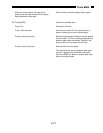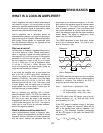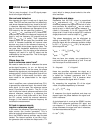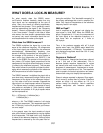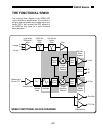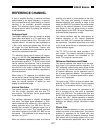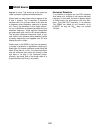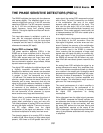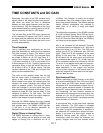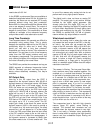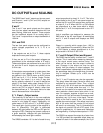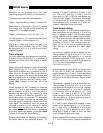
3-7
SR850 Basics
A lock-in amplifier requires a reference oscillator
phase-locked to the signal frequency. In general,
this is accomplished by phase-locking an internal
oscillator to an externally provided reference
signal. This reference signal usually comes from
the signal source which is providing the excitation
to the experiment.
Reference Input
The SR850 reference input can accept an analog
signal (like a sine wave) or a TTL logic signal. The
first case is called External Sine. The input is AC
coupled (above 1 Hz) and the input impedance is
1 MΩ. A sine wave input greater than 200 mV pk
will trigger the input discriminator. Positive zero
crossings are detected and considered to be the
zero for the reference phase shift.
TTL reference signals can be used at all frequen-
cies up to 102 kHz. For frequencies below 1 Hz,
a TTL reference signal is required. Many func-
tion generators provide a TTL SYNC output which
can be used as the reference. This is convenient
since the generator's sine output might be smaller
than 200 mV or be varied in amplitude. The SYNC
signal will provide a stable reference regardless of
the sine amplitude.
When using a TTL reference, the reference input
can be set to External Rising (detect rising edges)
or External Falling (detect falling edges). In each
case, the internal oscillator is locked (at zero
phase) to the detected edge.
Internal Oscillator
The internal oscillator in the SR850 is basically a
100 kHz function generator with sine and TTL
sync outputs. The oscillator can be phase-locked
to the external reference.
The oscillator generates a digitally synthesized
sine wave. The digital signal processor, or DSP,
sends computed sine values to a 16 bit digital-to-
analog converter every 4 µs (256 kHz). An anti-
aliasing filter converts this sampled signal into a
low distortion sine wave. The internal oscillator
sine wave is output at the SINE OUT BNC on the
front panel. The amplitude of this output may be
set from 4 mV to 5 V.
When an external reference is used, this internal
REFERENCE CHANNEL
oscillator sine wave is phase-locked to the refer-
ence. The rising zero crossing is locked to the
detected reference zero crossing or edge. In this
mode, the SINE OUT provides a sine wave phase-
locked to the external reference. At low frequen-
cies (below 10 Hz), the phase locking is accom-
plished digitally by the DSP. At higher frequencies,
a discrete phase comparator is used.
The internal oscillator may be used without an
external reference. In the Internal Reference
mode, the SINE OUT provides the excitation for
the experiment. The phase-locked-loop is not used
in this mode since the lock-in reference is provid-
ing the excitation signal.
The TTL OUT on the rear panel provides a TTL
sync output. The internal oscillator's rising zero
crossings are detected and translated to TTL
levels. This output is a square wave.
Reference Oscillators and Phase
The internal oscillator sine wave is not the refer-
ence signal to the phase sensitive detectors. The
DSP computes a second sine wave, phase shifted
by θ
ref
from the internal oscillator (and thus from
an external reference), as the reference input to
the X phase sensitive detector. This waveform is
sin(ω
r
t + θ
ref
). The reference phase shift is adjust-
able in .001° increments.
The input to the Y PSD is a third sine wave, com-
puted by the DSP, shifted by 90° from the second
sine wave. This waveform is sin(ω
r
t + θ
ref
+ 90°).
Both reference sine waves are calculated to 20
bits of accuracy and a new point is calculated
every 4 µs (256 kHz). The phase shifts (θ
ref
and
the 90° shift) are also exact numbers and accurate
to better than .001°. Neither waveform is actually
output in analog form since the phase sensitive
detectors are actually multiply instructions inside
the DSP.
Phase Jitter
When an external reference is used, the phase-
locked loop adds a little phase jitter. The internal
oscillator is supposed to be locked with zero
phase shift relative the external reference. Phase
jitter means that the average phase shift is zero
but the instantaneous phase shift has a few milli-



